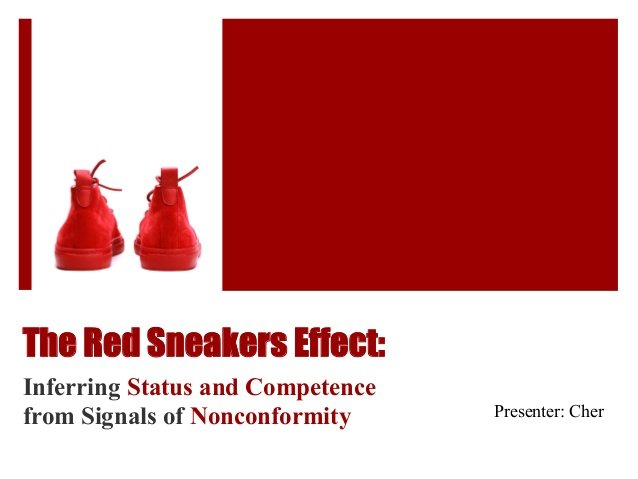Most of us spend so much time and money trying to get our heads around dress codes and etiquette.
This dutiful compliance with the official rules and norms signifies we are knowledgeable, resourceful and that we are professional.
But should we take a different approach?
Standing out from the crowd.
Standing out, rather than fitting in, could actually be a smarter route to success.
A phrase that was coined by the Journal of Consumer Research in 2014; the “Red Sneaker Effect’. It revealed that people confer higher status and competence on the free spirit rather than the conformists.
So we often perceive someone wearing clothing that deviates from the norm in professional settings as having a higher rank and respect than others who conform. Case in point, Mark Zuckerberg, CEO and Founder of Facebook, is also popular for wearing Jeans and a grey t-shirt.

This is because diverging from the norm signals you have autonomy and can bear the cost of nonconformity.
Silvia Bellezza, an associate professor at Columbia business school and one of the authors argues that “We often think that divergence from cultural norms has a ‘social cost’, rather than a positive consequence.”
She continues saying “risk-taking signals that you have enough social capital to maintain your status even if nonconformity backfires.”
Many successful people have flouted convention, take Apple’s Steve Jobs who ditched his suit and tie for a black turtleneck.

Rulebreakers
Even in industries with relaxed dress codes such as tech, many high profile women still sport a more conventional formal dress code, take Sheryl Sandberg.

This mostly reflects that there are a lot more white men in senior positions than women and minorities. Therefore, the men are in a position to break the established rules.
However, it was pointed out the women and ethnic minorities working in fields traditionally dominated by white men, are forced to conform to the norm because they already don’t fit.
Of course, men are also criticized for informality too. A former BBC economics editor, Robert Peston, was slated for slouching and revealing his chest hair with a tie-less collar in an interview.

The backlash was consistent with research by Namrata Goyal, an associate research scholar at Columbia Business School, found that nonconforming behavior backfires when people violate “injunctive” norms, i.e; unwritten rules which are respected: for example, wearing a tie to meet a client, which conveys reverence.
In Peston’s case, the British political establishment is still snared in formality. That is until recently, centuries of tradition dictated that male MPs had to wear ties to address parliament.
Does This Mean The ‘Red Sneaker Effect’ is most powerful in more casual industries such as technology?
Bellezza argues that the opposite is true. She says that in banking or government, for instance, deviating from the norm could offer the richest rewards – because the behavior will be perceived as nonconforming.
In an industry like tech, wearing a t-shirt and sneaker has become a norm. The study found norm violators were seen as more powerful than conformists. It also found that they evoke less outrage in individualistic cultures, such as much of the western world.
But she found that in collective cultures, such as East Asia and Latin America, people prefer norm followers as leaders, because they may prioritize organizational goals over their own.
Since different people view different behaviors differently in different contexts, the red sneakers effect is highly individualized.
Understanding the research is essential in using it to a good effect. “Understanding who observes the non-conforming behavior and where it’s done is the key to making it work for you.”

